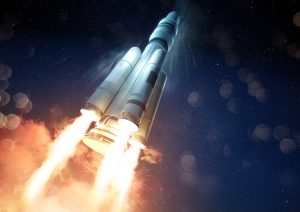Spacecraft designers have two proven propulsion technologies they can use for developing vehicles for robotic and crewed missions: chemical, which offers a high thrust-to-weight ratio but isn’t very efficient, and electrical, which is more efficient but offers a low thrust-to-weight ratio.
Now a third alternative is emerging as a potentially viable technology far better suited for deep-space exploration, including sending astronauts

to Mars and returning them to Earth. The benefits of such a system are compelling. For starters, a nuclear-powered spacecraft would cut about a year off the round-trip duration of a crewed Mars mission. That’s huge, because long-term exposure of astronauts to the hazards of cosmic radiation and prolonged weightlessness are major concerns. The engineering case is no less attractive. A nuclear propulsion system would offer virtually unlimited energy density compared to the best chemical rockets and solar electric propulsion.
NASA is reviewing industry responses to the first phase of a plan with the Department of Energy (DOE) to mature a prototype. Meanwhile, the Defense Advanced Research Projects Agency recently awarded contracts to several companies in the first phase of a program to develop a nuclear thermal propulsion (NTP) system for cislunar (the space between the Earth and the moon), targeting a full-scale, on-orbit demonstration in 2025.
For its part, NASA expects to begin Phase 1 of its R&D program with contract awards in July. Follow-on phases will include building and testing technology demonstrators prior to the construction of an operational NTP system to propel a crewed mission to Mars by 2039. DOE’s request for preliminary proposals, issued in February, calls for preliminary design of an NTP reactor using a high-assay low-enriched uranium fuel.
In NASA’s program, the new capability could be based on either a NTP reactor and engine or synergistic nuclear electric propulsion (NEP) technology. The NTP system would involve a nuclear fission reactor—similar to what commercial nuclear power plants use to generate electricity—that would use heat to convert a liquid propellant, such as liquid hydrogen, to a gas that expands through a nozzle, creating thrust. An NEP system would use a fission reactor to generate electricity that positively charges gas propellants, such as xenon, propelling the ions through a thruster.
The specific impulse of the NTP would be around 900 seconds, or twice that of rockets. (Specific impulse is a measure, usually in seconds, of the efficiency with which a rocket engine utilizes its propellants, and is equal to the number of pounds of thrust produced per pound of propellant burned per second.) The NEP system, which would propel spacecraft for extended periods using a small fraction of the fuel of high-thrust systems, would have a specific impulse of 4,000 seconds. Both would generate about one megawatt of power.
Regardless of which propulsion system NASA selects, both will require in-orbit assembly for integrated in-space testing and eventual use. 
In order to reach that point, however, engineers will need to overcome major technical hurdles. Among the most formidable is figuring out how to integrate a fission reactor into a viable propulsion system. The most likely configuration is a solid core reactor, which produces higher temperatures than conventional materials can withstand.
Momentum is building behind nuclear propulsion technology because “the [need] case” has changed in recent decades, particularly with NASA’s focus on developing the capabilities for Mars missions, according to Anthony Calomino, nuclear technology portfolio lead within NASA’s Space Technology Mission Directorate. “We’ve been looking at nuclear propulsion for the Mars mission, and the timelines in terms of developing those technologies have shortened.”
Moreover, certain enabling technologies—most notably materials and manufacturing processes—have reached a tipping point where nuclear-powered space vehicles are within scientific reach. He also believes that NASA’s nuclear space plan is more realistic than previous attempts. “We’ve had a couple of decades of advances, and I believe that the materials that we have today are not the same suite of capabilities that we had,” Calomino said.
In addition to materials that are more heat resistant, another big challenge is the ability to bring the reactor to full operating temperature rapidly, according to a recent National Academy of Sciences report on space nuclear propulsion for crewed Mars missions. Other big challenges include long-term storage of liquid hydrogen in space, overcoming the lack of adequate ground-test facilities, and dealing with the long-duration temperatures (around 4,400 derees F) of the propellant at the reactor exit.
Deciding on NTP versus NEP will come down to how NASA’s Mars architecture evolves, according to Calomino. From an engineering perspective, decisions will depend on technology readiness levels, timelines and the “aggressiveness that [NASA] needs to advance those capabilities,” he said. “Then there are the operational risks and costs to getting these capabilities online.”